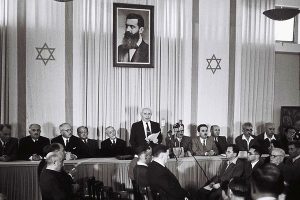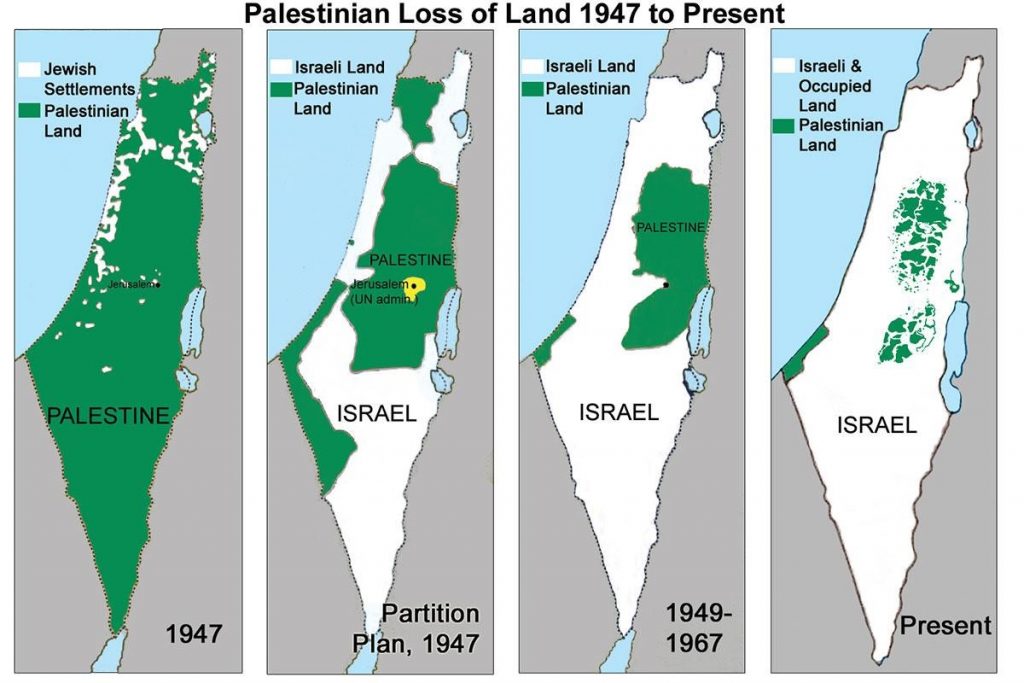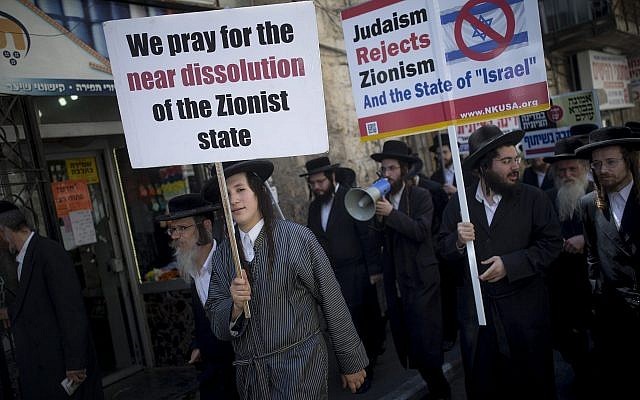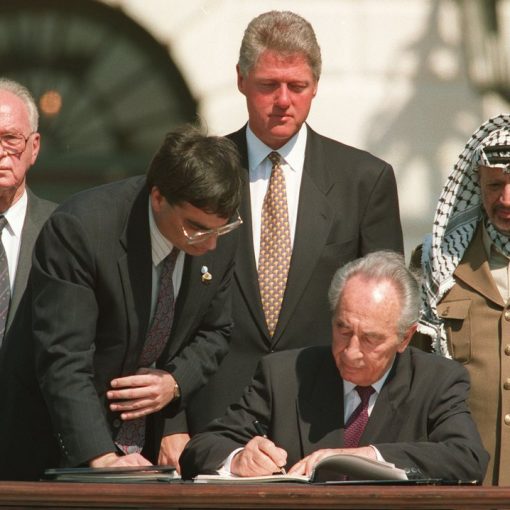Key takeaways:
- The identity of Israel as a state was defined at the time of its founding by three ideals: Israel was to be a democratic, a Jewish state, and constitute all the ancient holy land claimed by the Jewish people
- The existence of modern-day Palestine and its Muslim population has meant that these three ideals could never be realised all at once, creating an identity crisis for Israel as a state
- The ever-growing Israeli settler movement in the West Bank since 1967 has brought this identity crisis regarding the three aims to the fore for Israeli society, and Israeli leadership has failed to address this problem
- This unaddressed identity crisis is exacerbated by the fragmented factions which constitute Israeli Jewish society, who each have individual and conflicting ideas of what the identity of the state of Israel is
The three goals of the Zionist movement

The Zionist movement had three immutable ambitions for Israel: firstly, it was to be a Jewish state; secondly, it was to be a democratic state; and thirdly, it was to regain all the biblical territory historically claimed by the Jewish people. Upon the establishment of the Israeli state in 1948, its founding leader, David Ben-Gurion, had no choice but to settle at the time for only two of the three objectives – the objectives of the Jewish and democratic state but not the objective of regaining all the land of Israel. While United Nations Resolution 181 – the resolution that resulted in the formation of the Israeli state separate from Palestine in 1948 – quashed Israel’s designs of regaining Palestine at the time, Ben-Gurion’s statement at the 1937 Zionist Congress in Zurich highlighted the impossibility of the territorial objective ever being sacrificed,
“If we were offered a Jewish state in the western land of Israel in return for our relinquishing our historical right over the whole land of Israel, then I would postpone the state. No Jew has the right to relinquish the right of the Jewish people over the whole land of Israel. It is beyond the power of any Jewish body. It is even beyond the power of the whole of the Jewish people living today to give up any part of the land of Israel.”
This reflects the core tenet of the Labor Zionist program – the Zionist movement upon which Israel was established – of ‘redeeming’ and settling the entirety of Israel. The West Bank – as the heartland of Jewish consciousness due to its biblical prevalence – is the prime focus of this settling process. The problem for Israeli leaders since 1948 has been that it is, by definition, impossible to officially regain this territory while still maintaining the other two immutable ambitions for the state of Israel – that of Israel being a Jewish state and a democracy. This becomes apparent when surveying the three choices Israel has available regarding these three ambitions:
Choice 1: If Israel were to officially regain all of Palestine but remain a Jewish state, then Israel would not be a fully democratic state because the rights of the Muslim Palestinians would be marginalised
Choice 2: If Israel were to officially regain all of Palestine but remain a democracy, then it would no longer be a Jewish state because the Palestinian population would be able to vote to overturn the Jewish character of the state
Choice 3: If Israel is to remain a Jewish state and a democracy, then it will not be able to officially regain Palestine for the reasons just outlined.
Avoiding the question: the early decades of the settler movement

The process of dealing with this ‘identity dilemma’ has become even more fraught since the beginning of Israeli settlements in the West Bank in 1967. Both the Labor and Likud parties avoided the difficult existential questions the settlement building poses to the identity of Israel as a state by formally maintaining the territorial status of the West Bank as Palestinian, while creating a different reality on the ground in the form of Israeli settlements.
However, there was a difference in the mindsets that drove Labor and Likud respectively to take this ‘avoiding the question’ approach. For Labor, this approach meant they could still point to the de jure status of the West Bank as Palestinian territory, enabling them to reconcile the situation with Labor’s humanistic and socialist founding ideology. For Likud, this approach meant they could point to the de facto status of the occupied territories as Israeli territory, enabling them to reconcile the situation with their guiding aim of annexing ‘Judea’ and ‘Samaria’ while ignoring the reality that formal, de jure reclamation of Palestine is politically nearly impossible.
While Likud is the party most typically associated with open designs on settling Palestine for Israel, Labor also has a deep-seated proclivity with establishing Israeli roots in the West Bank. The early years of Israeli settlements in the West Bank occurred under the watch of Labor Prime Ministers from 1967-77 after Labor’s annexation of the Old City of Jerusalem following the 1967 war. This 1967 annexation set the scene for Israeli settlers to then begin building settlements in the West Bank, to which the Labor government would only respond half-heartedly, with some Labor ministers openly supporting the settlements. The Labor governments would do just enough to be able to maintain a minimum level of distance from the settler movement, but the connection the movement established between Israel and its biblical past was similarly attractive for Labor as it was for Likud.
The ‘avoiding the question’ approach has become entrenched because both sides of politics believe that the depth of divisions in Israeli society over the question – of what mix of a democratic state, a Jewish state, and a state which occupies all of ancient Israel, Israel should be – are so deep that properly addressing the question may lead to civil conflict. The source of this belief lies in Israeli leaders’ experience with and observance of the neighbouring Lebanese Civil War in the 1970s and 80s – with that war’s origin being in Lebanese society’s engagement with a similar identity tussle.
Avoiding the question: the effect of fragmented Israeli Jewish society
It is possible to begin to understand the nature of this division in Israeli society by looking at the main factions of Israeli Jews.
Secular or non-observant Jews (around ½)
For this faction, the idea of the Jewish state – and the activities like military service, national holidays etc. that reinforce this idea – have replaced Judaism as the dominant focus. The idea of the Jewish state plays a far more important role for the identity of this group than does Judaism.
Religious Zionists (a bit more than ⅓)
This faction fully support the ideal of the Jewish state, but don’t see it as a replacement for Judaism – both the state and the synagogue are equally important.
Within this faction are a sub-faction of religious Zionists who are of a more messianic bent. This sub-faction believe that the creation of the Israeli state was the first stage leading to the eventual coming of the Messiah and that the state’s sole role is to facilitate this coming. It is this messianic sub-faction that has traditionally formed the backbone of the settler movement.
Ultra-orthodox Jews, or Haredim (a bit less than ⅙)

Members of this faction typically don’t participate in activities that re-enforce the idea of the Jewish state (military service, national holidays, etc.). Haredim don’t perceive the creation of Israel as a significant religious event and primarily want to live in Israel because they feel closer to God there, not because of any Zionist goals. This faction only serves in parliament to advance their ultra-orthodox ideals, not to strengthen the idea of the Jewish state.
The issue is that these factions haven’t engaged with each other to agree on a consensus for the identity of the state of Israel – primarily because each believed that the other factions would disappear over time. As such, their different competing visions for the meaning of the state have grown side by side, leaving a fragmented society that is divided over how to pursue the three pillars that define the identity of Israel.
References
Friedman, T. (1998). From Beirut to Jerusalem. Harper Collins, pp. 253-54, 258-60, 262, 266-67, 269-70, 285-88.

